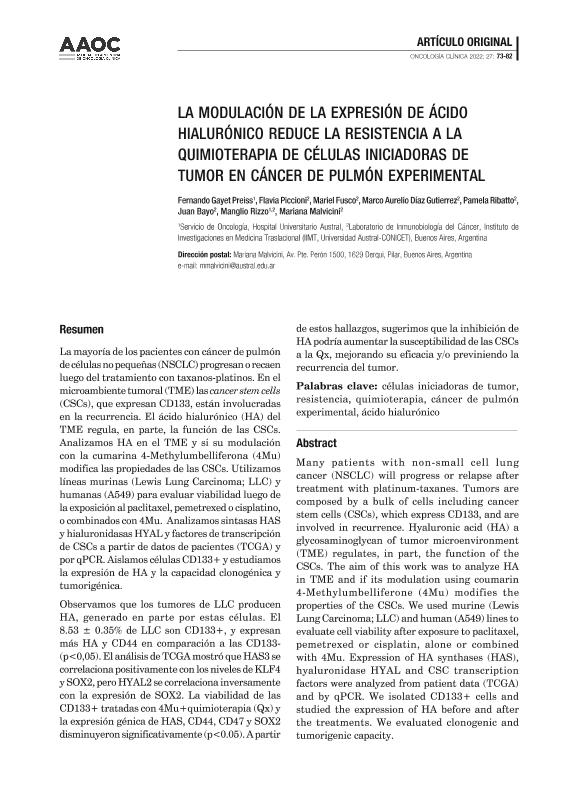Artículo
La mayoría de los pacientes con cáncer de pulmón de células no pequeñas (NSCLC) progresan o recaen luego del tratamiento con taxanos-platinos. En el microambiente tumoral (TME) las cancer stem cells (CSCs), que expresan CD133, están involucradas en la recurrencia. El ácido hialurónico (HA) del TME regula, en parte, la función de las CSCs. Analizamos HA en el TME y si su modulación con la cumarina 4-Methylumbelliferona (4Mu) modifica las propiedades de las CSCs. Utilizamos líneas murinas (Lewis Lung Carcinoma; LLC) y humanas (A549) para evaluar viabilidad luego de la exposición al paclitaxel, pemetrexed o cisplatino, o combinados con 4Mu. Analizamos sintasas HAS y hialuronidasas HYAL y factores de transcripción de CSCs a partir de datos de pacientes (TCGA) y por qPCR. Aislamos células CD133+ y estudiamos la expresión de HA y la capacidad clonogénica y tumorigénica. Observamos que los tumores de LLC producen HA, generado en parte por estas células. El 8.53 ± 0.35% de LLC son CD133+, y expresan más HA y CD44 en comparación a las CD133- (p<0,05). El análisis de TCGA mostró que HAS3 se correlaciona positivamente con los niveles de KLF4 y SOX2, pero HYAL2 se correlaciona inversamente con la expresión de SOX2. La viabilidad de las CD133+ tratadas con 4Mu+quimioterapia (Qx) y la expresión génica de HAS, CD44, CD47 y SOX2 disminuyeron significativamente (p<0.05). A partir de estos hallazgos, sugerimos que la inhibición de HA podría aumentar la susceptibilidad de las CSCs a la Qx, mejorando su eficacia y/o previniendo la recurrencia del tumor. Many patients with non-small cell lung cancer (NSCLC) will progress or relapse after treatment with platinum-taxanes. Tumors are composed by a bulk of cells including cancer stem cells (CSCs), which express CD133, and are involved in recurrence. Hyaluronic acid (HA) a glycosaminoglycan of tumor microenvironment (TME) regulates, in part, the function of the CSCs. The aim of this work was to analyze HA in TME and if its modulation using coumarin 4-Methylumbelliferone (4Mu) modifies the properties of the CSCs. We used murine (Lewis Lung Carcinoma; LLC) and human (A549) lines to evaluate cell viability after exposure to paclitaxel, pemetrexed or cisplatin, alone or combined with 4Mu. Expression of HA synthases (HAS), hyaluronidase HYAL and CSC transcription factors were analyzed from patient data (TCGA) and by qPCR. We isolated CD133+ cells and studied the expression of HA before and after the treatments. We evaluated clonogenic and tumorigenic capacity. We observed that LLC tumors produce HA, generated in part by these cells. The 8.53 ± 0.35% of LLC are CD133+, and express more HA and CD44 compared to CD133- (p<0.05). The TCGA analysis showed that HAS3 is positively correlated with the levels of KLF4 and SOX2, while HYAL2 is inversely correlated with the expression of SOX2. The viability of CD133+ treated with 4Mu+chemotherapy (Qx) and the gene expression of HAS, CD44, CD47 and SOX2 decreased significantly (p<0.05). Based on this evidence, we suggest that inhibition of HA could increase the susceptibility of CSCs to Qx, improving their effectiveness and/or preventing tumor recurrence.
La modulación de la expresión de ácido hialurónico reduce la resistencia a la quimioterapia de células iniciadoras de tumor en cáncer de pulmón experimental
Gayet Preiss, Fernando; Piccioni, Flavia Valeria ; Fusco, Mariel Alejandra
; Fusco, Mariel Alejandra ; Díaz Gutierrez, Marco Aurelio; Ribatto, Pamela; Bayo Fina, Juan Miguel
; Díaz Gutierrez, Marco Aurelio; Ribatto, Pamela; Bayo Fina, Juan Miguel ; Rizzo, Manglio Miguel
; Rizzo, Manglio Miguel ; Malvicini, Mariana
; Malvicini, Mariana
 ; Fusco, Mariel Alejandra
; Fusco, Mariel Alejandra ; Díaz Gutierrez, Marco Aurelio; Ribatto, Pamela; Bayo Fina, Juan Miguel
; Díaz Gutierrez, Marco Aurelio; Ribatto, Pamela; Bayo Fina, Juan Miguel ; Rizzo, Manglio Miguel
; Rizzo, Manglio Miguel ; Malvicini, Mariana
; Malvicini, Mariana
Fecha de publicación:
12/2022
Editorial:
Asociacion Argentina de Oncología Clínica
Revista:
Oncología Clínica
ISSN:
1669-6336
e-ISSN:
1669-6336
Idioma:
Español
Tipo de recurso:
Artículo publicado
Clasificación temática:
Resumen
Archivos asociados
Licencia
Identificadores
Colecciones
Articulos(IIMT)
Articulos de INSTITUTO DE INVESTIGACIONES EN MEDICINA TRASLACIONAL
Articulos de INSTITUTO DE INVESTIGACIONES EN MEDICINA TRASLACIONAL
Citación
Gayet Preiss, Fernando; Piccioni, Flavia Valeria; Fusco, Mariel Alejandra; Díaz Gutierrez, Marco Aurelio; Ribatto, Pamela; et al.; La modulación de la expresión de ácido hialurónico reduce la resistencia a la quimioterapia de células iniciadoras de tumor en cáncer de pulmón experimental; Asociacion Argentina de Oncología Clínica; Oncología Clínica; 27; 2; 12-2022; 73-82
Compartir
Altmétricas



